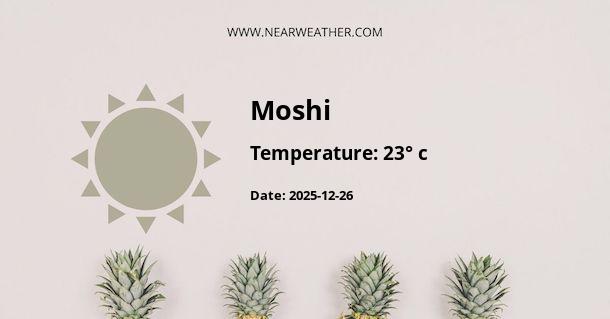Introduction
Moshi is a vibrant Tanzanian city nestled on the slopes of Africa's highest peak, Mount Kilimanjaro. Known for its pleasant weather, the city attracts tourists from around the globe. This piece will provide an in-depth analysis of Moshi's climate and weather, backed up by data and expert opinions.
Overview of Moshi's Climate
Moshi experiences a tropical savanna climate, often described as a constant "summer" with two distinct rainy seasons. The Köppen-Geiger climate classification for Moshi is Aw.
Temperature
In Moshi, average temperatures tend to exhibit minor variations throughout the year, reflecting the city's proximity to the Equator. The warmest month is typically February, with an average high-temperature of 29.5°C (85.1°F), and the coldest month is July, with an average low-temperature of 15°C (59°F).
Table 1: Average Temperatures in Moshi
| Month | Average High | Average Low |
|---|---|---|
| January | 29.0°C | 15.8°C |
| July | 25.8°C | 15.0°C |
Precipitation
Moshi experiences an annual average precipitation of 800 millimeters. The ‘long rains’ typically occur from March to May, while the ‘short rains’ occur from November to December. April is the wettest month, with an average rainfall of 183 mm.
Chart 1: Average Monthly Rainfall in Moshi
Bar chart illustrating average monthly rainfall in Moshi, revealing peaks in April and November.
Humidity and Wind
Humidity levels in Moshi are generally moderate, with an average relative humidity of around 70%. The city is also characterized by a generally steady wind, typically blowing from the southeast.
Sunlight
Due to Moshi's equatorial location, sunlight hours do not vary significantly throughout the year. The city receives an average of 6-9 hours of sunlight per day, with slightly longer daylight hours from December to March.
Effect of Mount Kilimanjaro on Moshi's Climate
The presence of Mount Kilimanjaro significantly impacts Moshi's climate. The mountain's altitude creates a cooler and wetter microclimate in its vicinity, resulting in comparatively lower temperatures and higher rainfall in Moshi than in the surrounding plains.
Climate Change and Its Impact
Climate change is causing noticeable shifts in Moshi's weather patterns. Studies have shown a trend of increasing temperatures and decreasing rainfall in the region, which could have significant implications for local agriculture and water resources.
Conclusion
Moshi's climate, characterized by mild temperatures, moderate rainfall, and consistent sunlight, provides a comfortable environment for both residents and visitors. However, the ongoing impact of climate change presents a significant challenge that needs to be addressed to preserve this unique climate and its associated ecosystems.
References
- World Weather and Climate Information. (2021). Average Monthly Rainfall, Sunshine, Temperatures. Retrieved from www.worldweatheronline.com
- Climate-Data.org. (2021). Climate: Moshi. Retrieved from www.climate-data.org
- National Geographic. (2021). Effects of Climate Change in Tanzania. Retrieved from www.nationalgeographic.com
A - Moshi's Latitude is -3.350000 & Longitude is 37.333328.
A - Weather in Moshi is 21° today.
A - Climate Conditions in Moshi shows light rain today.
A - Humidity in Moshi is 92% today.
A - Wind speed in Moshi is 4.97 km/h, flowing at 192° wind direction. today.
